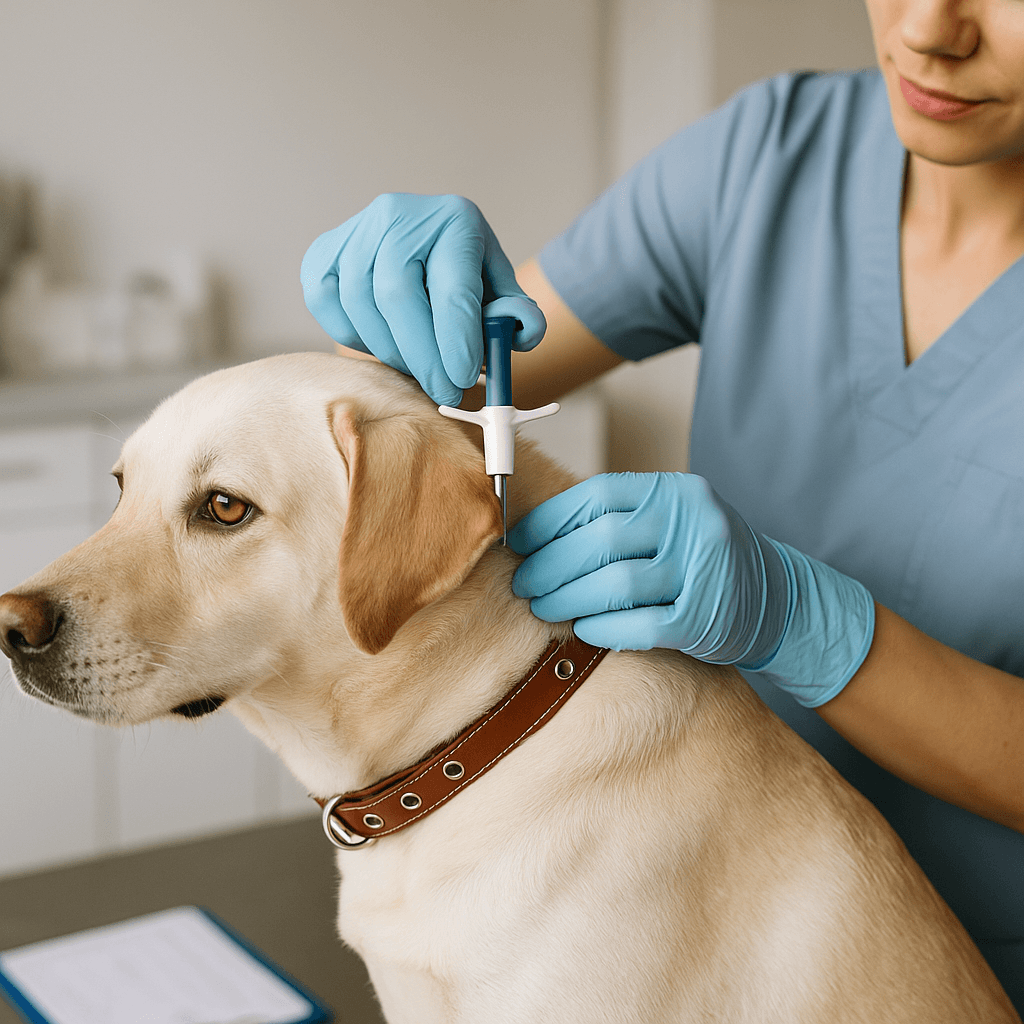Picture the devastation of losing your dog — only to discover there's no possible way for someone to recognize and return your pet. Microchipping is where that ends. As a permanent, foolproof form of pet identification, microchipping your dog greatly improves the possibility of safe return should they ever get lost or stolen.
This guide takes you step-by-step through all there is to know about dog microchipping, from how it works to the advantages, worries, and FAQs — all presented in plain language to assist pet parents in making informed choices.
What Is a Dog Microchip and How Does It Work?
A dog microchip is a tiny device, about the size of a grain of rice, implanted just beneath your dog’s skin — usually between the shoulder blades. It uses radio-frequency identification (RFID) technology to store a unique ID number.
How Microchips Work:
- When a scanner is passed over the chip, it emits a radio signal.
- The chip transmits its ID number to the scanner.
- The number links to a database containing the owner’s contact details.
Important: Microchips do not contain GPS or tracking capabilities.
Why Microchipping Your Dog Is Important
The Role of Microchips in Pet Recovery
According to the American Veterinary Medical Association (AVMA), microchipped dogs are more than twice as likely to be returned to their owners compared to those without chips.
Some scenarios where microchips are invaluable:
- Dogs that escape during thunderstorms or fireworks
- Pets stolen or sold without permission
- Dogs that lose their collar or ID tag
Pros and Cons of Microchipping Your Dog
✅ Pros:
- Permanent form of identification
- Increases recovery chances if lost or stolen
- Quick, safe, and minimally invasive procedure
- Lifetime protection (no need to replace the chip)
- Often required for travel or international relocation
❌ Cons:
- Not a GPS tracker – it won’t tell you your dog’s location
- Owner must update contact info in the database
- Rare complications like migration of the chip or allergic reactions
- Not all scanners are universal, though most modern shelters and vets can read all major brands
Key Benefits of Microchipping Your Dog
- 1. Peace of Mind: Knowing your dog has a permanent form of ID offers comfort, especially during travel or walks off-leash.
- 2. Fast Reunification: Microchipped pets are returned faster because vets and shelters immediately scan new arrivals.
- 3. Proof of Ownership: In legal disputes or theft cases, a microchip provides verifiable proof that the dog belongs to you.
- 4. Supports Local Laws: In many regions, microchipping is mandatory by law — especially for breeders or those selling dogs.
How Much Does It Cost to Microchip a Dog?
Microchipping is an affordable investment. On average, it costs between $25 and $60 in the U.S., depending on the clinic and whether the procedure is bundled with other services.
Some animal shelters and rescue organizations offer microchipping at reduced rates or even for free during special events.
When and Where to Get Your Dog Microchipped
Most dogs can be microchipped at any age, but it’s typically done when they’re puppies (around 6-8 weeks). If your dog is older, it’s never too late.
Where to Get It Done:
- Veterinary clinics
- Animal shelters
- Pet adoption centers
- Mobile pet clinics
Make sure the microchip provider uses an ISO-compliant chip, which is more likely to be universally scannable.
Best Practices After Microchipping Your Dog
After the procedure, you need to:
- Register your contact info in the chip manufacturer’s database
- Keep your details up to date, especially if you move or change phone numbers
- Have your dog scanned during annual vet visits to ensure the chip is working and hasn’t moved
Conclusion: Give Your Dog a Better Chance to Find Their Way Home
Microchipping your pet is an intelligent, responsible, and possibly lifesaving move. It's a cheap, safe, and significantly enhanced way to improve chances of reuniting with your pet should the unthinkable occur.
At the end of the day, your dog is one of the family — and microchipping is one of the best things to do to keep them safe.
Ready to get started? Schedule a microchipping appointment with your veterinarian today — and take one more step toward responsible pet ownership.
Frequently Asked Questions (FAQs)
1. Does microchipping hurt my dog?
2. Can the chip be removed or deactivated?
3. What if I get a dog that's already microchipped?
4. Can I microchip my dog myself?
5. Is microchipping the same as GPS tracking?

About SniffnTail
SniffnTail is your go-to destination for everything pets. From helpful advice, tips, and insights to thoughtfully selected products and resources, we’re here to support pet owners at every stage of their journey. Whether you're caring for a playful pup, a wise old cat, or anything in between, SniffnTail offers tools and knowledge to make pet parenting easier and more joyful.
Related Articles
 Training & Behavior • 6 min read
Training & Behavior • 6 min readMastering Dog Training Commands: Teach Your Pup Obedience with Love
Discover essential dog training commands every pet parent should know. From basic puppy commands to teaching obedience, learn how to train your dog with expert-backed tips.
 Training & Behavior • 7 min read
Training & Behavior • 7 min readHow to Train a Puppy Not to Bite Hands: Gentle, Effective Tips
Learn how to stop your puppy from biting hands with expert-backed, kind methods. Discover the difference between teething and aggression, and explore top techniques for bite inhibition puppy training.
 Training & Behavior • 7 minutes
Training & Behavior • 7 minutesWhat to Do If a Dog Attacks: A Pet Expert’s Guide to Staying Safe
Learn how to prevent dog attacks, recognize aggressive dog behavior, and protect yourself and your loved ones with practical, expert-backed advice.

